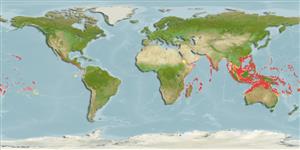Environment: milieu / climate zone / depth range / distribution range
Ekologi
laut; air tawar; payau dasar (demersal); katadromus (ruaya dari air tawar ke laut) (Ref. 51243); kisaran kedalaman 1 - 400 m (Ref. 6898). Tropical; 31°N - 35°S, 21°E - 134°W
Indo-Pacific: East Africa, inland Mozambique and lower Zambezi River to French Polynesia, north to southern Japan (Ref. 7050). Also rivers of Madagascar and adjacent islands (Ref. 52193).
Size / Weight / umur
Maturity: Lm ? range ? - ? cm
Max length : 70.0 cm TL jantan/; (Ref. 57749); 200.0 cm TL (female); common length : 26.3 cm TL jantan/; (Ref. 35840); Berat maksimum terpublikasi: 20.5 kg (Ref. 13337); Berat maksimum terpublikasi: 20.5 kg; Umur maksimum dilaporkan: 40 Tahun (Ref. 48660)
vertebrata, bertulang belakang: 100 - 110. Diagnosis: Distinguished from all other species by the mottled colour and the long dorsal fin, which begins closer to the gill opening than to the anus (Ref. 9828).
Live in freshwater areas as adults, estuaries and seas as young (Ref. 12693). Found in lowland rivers as well as upland tributaries (Ref. 2847). While in river, the sex gland does not develop. But in winter when they move from the stream to river mouth, the sex gland begins to develop as mature individuals go to deep sea to breed (Ref. 45563). The spawning grounds are deep sea gullies among the south of the Philippines, east of Indonesia and Papua New Guinea (Ref. 45563). Are active at night, feeding on a wide range of prey (Ref. 7248, 79840), especially crabs, frogs and fish (Ref. 7248). Thought to breed east of Madagascar where the young are wafted to the East Coast by ocean currents (Ref. 13337, 79840).
Life cycle and mating behavior
Kematangan | Reproduksi, perkembang biakan | Pemijahan | telur-telur | Fecundity | Larva
Castle, P.H.J., 1984. Anguillidae. p. 34-37. In J. Daget, J.-P. Gosse and D.F.E. Thys van den Audenaerde (eds.) Check-list of the freshwater fishes of Africa (CLOFFA). ORSTOM, Paris and MRAC, Tervuren. Vol. 1. (Ref. 3506)
Status IUCN Red List (Ref. 130435)
Warning: mysqli::__construct(): (HY000/1040): Too many connections in /var/www/html/includes/func_getlabel.php on line 46
Can't connect to MySQL database (fbapp). Errorcode: Too many connections
